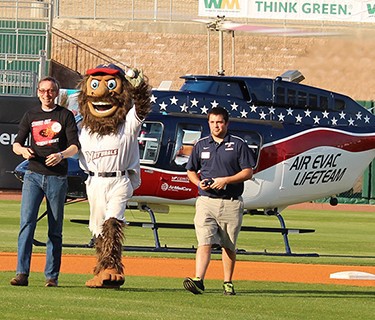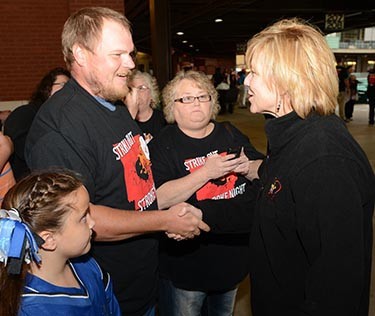Survivors Hurl Strikes Against Stroke
| 
Michael Manley, director of AR SAVES, left, Strike — Northwest Arkansas Naturals mascot, and J.R. Looper, R.N. at North Arkansas Regional Medical Center in Harrison, walk toward the pitcher’s mound at Arvest Park in Springdale. Representing AR SAVES nurses in Northwest Arkansas, Looper threw the ceremonial first strike against stroke.

UAMS Medical Center CEO Roxane Townsend, M.D., greets 500th ARSAVES patient Dustin Martinez and his family at the May 13 Strike Out Stroke event at Dickey-Stephens Park.

UAMS Medical Center CEO Roxane Townsend, M.D., throws out the first pitch during a pregame ceremony honoring the UAMS-led ARSAVES stroke program and the many patients it has served.

Free Strike Out Stroke night T-shirts were handed out to guests at Dickey-Stephens Park in North Little Rock to celebrate the UAMS ARSAVES stroke program.
May 23, 2014 | If a Dustin Martinez baseball card existed, it would have two noteworthy statistics on the back — first ceremonial strike thrown at Strike Out Stroke Night at Dickey-Stephens Park in North Little Rock and 500th stroke patient to receive a blood-clot dissolving agent through the UAMS-led AR SAVES program.
Martinez and Roxane Townsend, M.D., UAMS Medical Center CEO, threw their strikes against stroke May 13 at the AR SAVES Strike Out Stroke Night during a pregame ceremony at an Arkansas Travelers game against the Northwest Arkansas Naturals.
On April 10, survivors did the same at Arvest Park in Springdale before a game pitting the Northwest Arkansas Naturals against the Frisco, Texas Rough Riders – both games featuring teams from Minor League Baseball’s Class AA Texas League.
“Our Strike Out Stroke events are a complete success across the state,” said Michael Manley, director of the Arkansas Stroke Assistance through Virtual Emergency Support (AR SAVES). “Not only are they done at the local community level, but our partnerships with the Arkansas Travelers and the Northwest Arkansas Naturals are critical to reaching a larger audience about the signs and symptoms of stroke.”
A helicopter delivered the baseball at Arvest Park for the survivors to use, but weather forced the helicopter to be canceled at Dickey-Stephens Park.
Volunteers from AR SAVES sites around the state worked at stroke education booths at the ballparks to distribute informational materials and answer questions. Brain-shaped stress toys were thrown into the stands.
The AR SAVES program is a partnership between the UAMS Center for Distance Health, the state Department of Human Services, Sparks Regional Health System in Fort Smith, and 42 Arkansas hospitals.
The program uses a high-speed video communications system to help provide immediate, life-saving treatments to stroke patients 24 hours a day. The real-time video communication enables a stroke neurologist to evaluate whether emergency room physicians should use t-PA, a powerful blood-clot dissolving agent, within the critical three-hour period following the first signs of stroke.
After Martinez had a stroke while driving to work in November, paramedics rushed him to Conway Regional Medical Center, one of 42 AR SAVES sites at hospitals statewide. Along with his wife, he took part in a medical consultation via an AR SAVES video teleconference with Margaret Tremwel, M.D., at Sparks Regional Health System in Fort Smith. She recommended he receive t-PA and transportation by helicopter to UAMS Medical Center for additional care. He was released four days later.
Although he has some remaining numbness in his left hand, he has no other functional deficits and by Jan. 13 had returned to work.
Arkansas, which ranks first in the nation in stroke death rates, had 1,560 stroke-related deaths in 2011, according to the national Centers for Disease Control and Prevention. Since the program began Nov. 1, 2008, more than 2,038 patients have received stroke consults through AR SAVES and 575 patients have received t-PA.
“These two Strike Out Stroke events really put us over the top in the number of contacts it allows us to expose our message to about stroke,” Manley said. “Not only do we reach the fans that are there, but also those who listen by radio as well as the news coverage we receive. It’s priceless and a real home run for our program and the people we serve.”